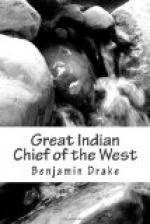“I do not permit the criers of our village or camps to proclaim any bad news against the whites, not even the truth. Last fall an old man, a Fox, was hunting on an island, a short distance below Rock river for turkeys to carry to Fort Armstrong: he was killed by a white man. My Father, we passed it over: we have only spoken of it in whispers; our agent has not heard of it. We wish to live in friendship with the whites; if a white man comes to our camp or village, we give him a share of what we have to eat, a lodging if he wants it, and put him on the trail if he has lost it.
“My Father, advise the criers of your villages to tell the truth respecting us, and assist in strengthening the chain of friendship, that your children may treat us friendly when they meet us: and be assured that we are friends, and have feelings as well as they have.
“My Father, this is all I have
to say at present.
“KEOKUK, Chief of the Sac nation.”
In the autumn of the year 1837, Keokuk and a party of his warriors made a visit to Washington city. Black Hawk was of the party, having been taken along, it is supposed by the politic Keokuk, lest in his absence, the restless spirit of the old man should create some new difficulties at home. We are indebted to a gentleman[7] who happened to be at the capital at the time of this visit, for the following sketch of a council, held under the direction of the Secretary at War, Mr. Poinsett, for the laudable purpose of reconciling the long cherished feeling of hostility between the Sacs and Foxes, and the Sioux,—a deputation of chiefs from this latter nation being also at the seat of government. The council was held in a church. The Indians were seated on a platform erected for the purpose, the spectators occupying the pews. The Secretary, representing the President, was seated on the center of the platform, facing the audience—the Sioux on his right hand and the Sauks and Foxes on his left, forming a semi-circle. “These hostile tribes, presented in their appearance a remarkable contrast. The Sioux tricked out in blue coats, epaulettes, fur hats and various articles of finery, which had been presented to them, and which were now incongruously worn in conjunction with portions of their own proper costume; while the Saukies and Foxes, with a commendable pride and good taste, wore their national dress, without any admixture, and were studiously painted according to their own notions of propriety. But the most striking object was Keokuk, who sat at the head of his delegation, on the extreme left, facing his mortal enemies the Sioux, who occupied the opposite side of the stage; having the audience upon his left side, and his own people on his right, and beyond them the Secretary at War. He sat grasping in his right hand the war banner, the symbol of his station as ruling chief. His person was erect and his eye fixed calmly but steadily upon the enemies of his people. On the floor,




